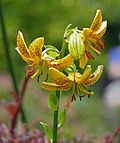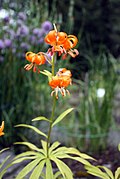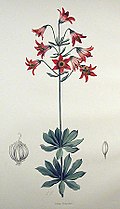Lilium
Lilium is a genus of herbaceous flowering plants growing from bulbs, all with large prominent flowers. They are a group of flowering plants which are important in culture and literature in much of the world. Most species are native to the temperate northern hemisphere, though their range extends into the northern subtropics.
Description[edit]
Lilium species are erect perennial plants ranging in height from 60 cm (2 ft) to 180 cm (6 ft). They form naked or tunicless scaly underground bulbs which are their perennating organs. In some North American species, the base of the bulb develops into rhizomes, on which numerous small bulbs are found. Some species develop stolons.
The flowers are large, often fragrant, and come in a wide range of colors including whites, yellows, oranges, pinks, reds, and purples. Markings include spots and brush strokes. The plants are late spring- or summer-flowering.
Taxonomy[edit]
The genus Lilium was first described by Carl Linnaeus in 1753. It is a member of the family Liliaceae. The genus contains around 100 species, which are divided into several sections based on their morphology and geographical distribution.
Distribution and Habitat[edit]
Lilium species are widely distributed across much of Europe, Asia, and North America. They are typically found in temperate and subtropical regions. They grow in a variety of habitats including woodlands, grasslands, and alpine meadows.
Cultivation[edit]
Lilies are among the most popular garden plants. They are usually grown from bulbs, which are planted in the autumn or spring. They prefer well-drained soil and a sunny position. Lilies are also grown commercially for their flowers, which are used in floral arrangements.
Uses[edit]
Lilies have been cultivated for their aesthetic value and are often used in gardens and floral arrangements. Some species are also used in traditional medicine. For example, the bulbs of some species are edible and have been used as food in some cultures.
Symbolism[edit]
Lilies have a rich symbolic history. In Christianity, the lily is often associated with the Virgin Mary and is a symbol of purity and chastity. In other cultures, lilies can symbolize fertility, renewal, and transformation.
Also see[edit]
|
Lilium[edit]
-
Lilium candidum
-
Lilium Stamens
-
Lily petal
-
Lilium
-
Lilium candidum
-
Lilium distichum
-
Hanson's Lily Lilium hansonii
-
Lilium martagon var. cattaniae
-
Lilium medeoloides
-
Lilium tsingtauense
-
Lilium bolanderi
-
Lilium columbianum
Ad. Transform your life with W8MD's Budget GLP-1 injections from $75


W8MD offers a medical weight loss program to lose weight in Philadelphia. Our physician-supervised medical weight loss provides:
- Weight loss injections in NYC (generic and brand names):
- Zepbound / Mounjaro, Wegovy / Ozempic, Saxenda
- Most insurances accepted or discounted self-pay rates. We will obtain insurance prior authorizations if needed.
- Generic GLP1 weight loss injections from $75 for the starting dose.
- Also offer prescription weight loss medications including Phentermine, Qsymia, Diethylpropion, Contrave etc.
NYC weight loss doctor appointmentsNYC weight loss doctor appointments
Start your NYC weight loss journey today at our NYC medical weight loss and Philadelphia medical weight loss clinics.
- Call 718-946-5500 to lose weight in NYC or for medical weight loss in Philadelphia 215-676-2334.
- Tags:NYC medical weight loss, Philadelphia lose weight Zepbound NYC, Budget GLP1 weight loss injections, Wegovy Philadelphia, Wegovy NYC, Philadelphia medical weight loss, Brookly weight loss and Wegovy NYC
|
WikiMD's Wellness Encyclopedia |
| Let Food Be Thy Medicine Medicine Thy Food - Hippocrates |
Medical Disclaimer: WikiMD is not a substitute for professional medical advice. The information on WikiMD is provided as an information resource only, may be incorrect, outdated or misleading, and is not to be used or relied on for any diagnostic or treatment purposes. Please consult your health care provider before making any healthcare decisions or for guidance about a specific medical condition. WikiMD expressly disclaims responsibility, and shall have no liability, for any damages, loss, injury, or liability whatsoever suffered as a result of your reliance on the information contained in this site. By visiting this site you agree to the foregoing terms and conditions, which may from time to time be changed or supplemented by WikiMD. If you do not agree to the foregoing terms and conditions, you should not enter or use this site. See full disclaimer.
Credits:Most images are courtesy of Wikimedia commons, and templates, categories Wikipedia, licensed under CC BY SA or similar.
Translate this page: - East Asian
中文,
日本,
한국어,
South Asian
हिन्दी,
தமிழ்,
తెలుగు,
Urdu,
ಕನ್ನಡ,
Southeast Asian
Indonesian,
Vietnamese,
Thai,
မြန်မာဘာသာ,
বাংলা
European
español,
Deutsch,
français,
Greek,
português do Brasil,
polski,
română,
русский,
Nederlands,
norsk,
svenska,
suomi,
Italian
Middle Eastern & African
عربى,
Turkish,
Persian,
Hebrew,
Afrikaans,
isiZulu,
Kiswahili,
Other
Bulgarian,
Hungarian,
Czech,
Swedish,
മലയാളം,
मराठी,
ਪੰਜਾਬੀ,
ગુજરાતી,
Portuguese,
Ukrainian











